#historical domain character
Text
feeling cute, might canon-weld the triumvirate (frank reade jr, jack wright, and robert trydan, evidently all dime novel science heroes gone bad; clevinger might’ve changed the names a bit though) to the helsingard criminal network
also i thought tom swift was in there so i might just throw him on the pile of “fallen boy’s adventure heroes who’ve pledged themselves to a mad austrian nobleman who thinks he can be the next alexander the great”
#atomic robo#billion-dollar plot is probably the most outright 'league of extraordinary gentlemen' that atomic robo has ever got#it's also got a few historical-domain characters who we know now to be...let's say questionable choices (winfield lovecraft. HP's father.#HE NAMED THE CAT THAT.)#clevinger has largely disengaged from the slight-alt-history stuff though. not sure if it's because of the 'new status quo' or that
1 note
·
View note
Note
I’m so sorry if you’ve already answered this somewhere, but how do you design your characters?
I’ve been trying to make an OC from the prohibition era and it turns out there’s basically nothing to work with for men’s outfits, so I’m curious how you made this many that look unique and fitting to the characters
There is so much to work with, though!
You will tend to find more of a focus on variety in women's fashion, but there is still quite a lot of menswear to ogle too.
I suppose it's just a matter of searching out ideas and inspiration in the rights corners. Here are a few suggestions:
Old Clothing Catalogues -
Collections from Sears-Roebuck and other popular clothing retailers are pretty easy to find compiled into relatively inexpensive books, or just floating online.
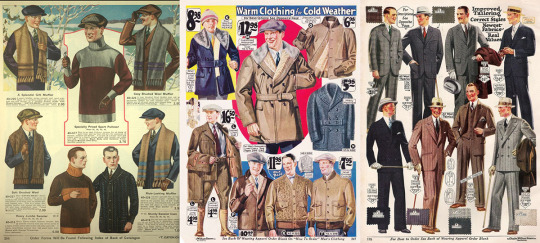
A fair bit of it is in the public domain now.
--Here's an entire 1922 catalogue of stuff to flip through.
-----------------
Contemporary Artwork -
Some phenomenal illustrators were working in this field amidst the "Golden Age of Illustration" and featured prominently on the covers of magazines and on the ads inside. There was a lot of emphasis on fashion.

Collier's and The Saturday Evening Post are a couple of the more prominent and easily searchable resources. The costuming on the cover art always has a lot of personality.
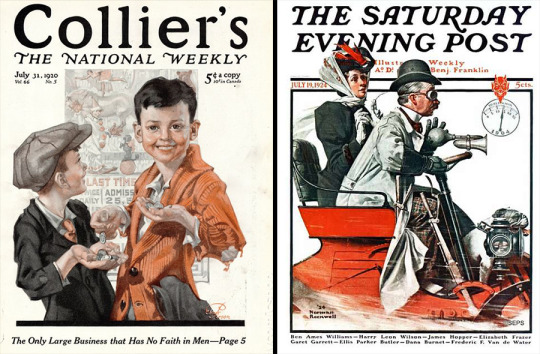
There's Rockwell, of course, and it's almost impossible to go wrong with J. C. Leyendecker. He's probably best known for his Arrow Collar ad art, but even his sock ads are like…
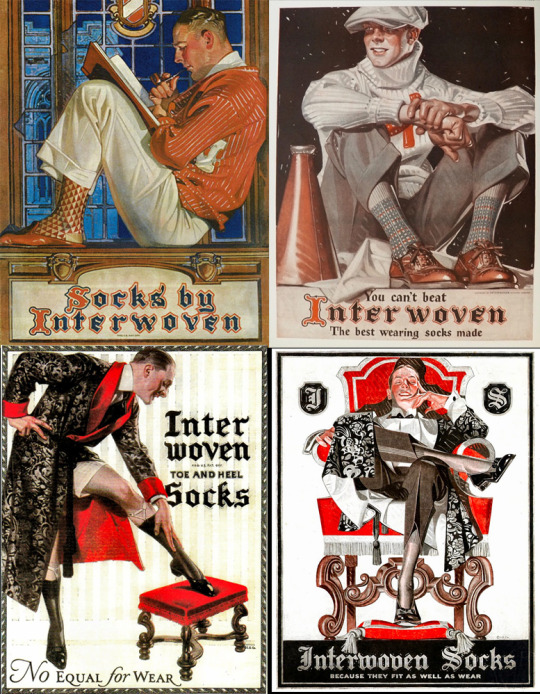
There were numerous other amazing and influential illustrators working at the time too. Here's a list of some of them.
Here's a bonus Henry Raleigh featuring some of his fabulously-dressed people.
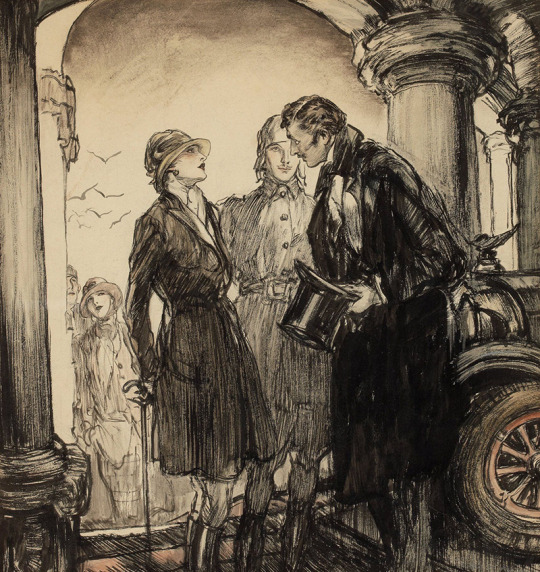
-----------------
Blogs and Articles -
There are so many of them!
If you want historical accuracy, be wary of write-ups pulling all of their references from film and television. There's nothing wrong with using those for inspiration if you aren't too concerned with historicity, but there are some pretty comprehensive and well-researched things out there with more of an eye on actual fashion history too:
--Gentleman's Gazette - What Men Really Wore in the 1920s
--The Fashionisto - 1920s Men's Fashion
-----------------
Digital Collections -
There are numerous digital historic image collections stemming from universities, museums, libraries, and the government that are free to peruse too.
--The Metropolitan Museum has a searchable catalog of exhibits that includes fashion and photos
--Here's some things from the New York Public Library
-----------------
Photos at Large -
If you aren't sure where to start, image searching for any of Hollywood's early celebrities will typically turn up a bevy of production stills and promotional photography featuring a variety of fashions.
Here's a random Getty images search for Harold Lloyd. A lot of standard 3 piece suits, but a lot of stuff with added character too.
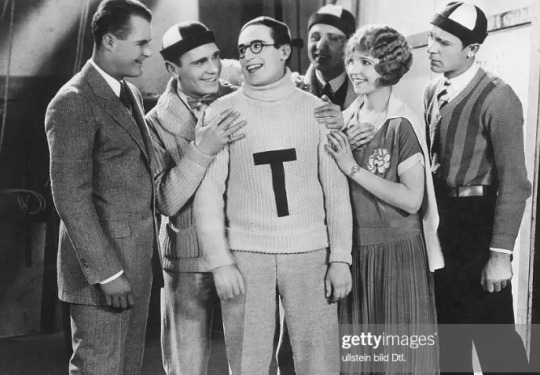
Photography was generally quite accessible by the 1920s, though, and you can find a lot of authentic photos of people from all walks of life, out in the wild wearing all sorts of clothes.
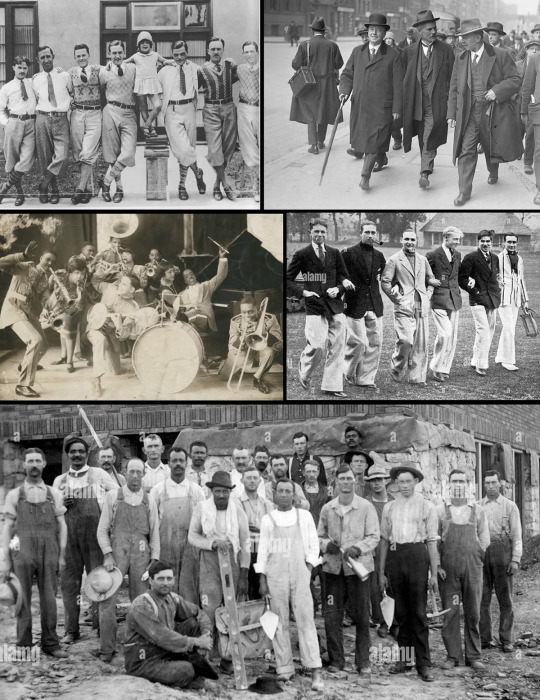
This is by no means the limit to the resources available, but hopefully it'll provide some leaping-off points for designing looks for your characters!
3K notes
·
View notes
Text

Today I learned that many members of a particular fandom somehow never knew that Stolas, a demon prince of hell who takes the form of a long legged owl, is a concept centuries old like every other big boss demon in that fandom and I know it's never anyone's fault that they just "aren't informed" but how could you possibly not just GUESS that from absolutely all surrounding context of that setting and those characters?? Why wouldn't you just instantly instinctively realize they must be references to classical mythical demons??? Hello????
Its sad that if you search Stolas in Google images you apparently get only one image of the original famous illustration from the Ars Goetia, which is a book from before the invention of internet cartoons or in fact electricity by the way. This first known image of stolas used to be 90% of the results. What the fuck. Why wouldn't image searches always be designed to include some of the oldest versions in the very first row? It shouldn't be possible to just make up anything and push down more authentic historical context through random Internet virality.
This isn't the fault of any cartoonist or creator and I didn't make this post to complain about the existence of any particular show, especially not one now apparently known to invite a bunch of hatemail of you express any strong opinions on it, I just can't believe the degree of mythological/folkloric illiteracy I always see from modern fandoms. Half the things you love are lifted from public domain fairy tales, guys. This same kind of thing has happened with Harry Pooters and stuff as basic as BASILISKS.
542 notes
·
View notes
Text
tbh i cannot pick my favorite part of dracula daily
is it the memes? the art, the serious and gorgeous and silly and charming art? the new designs and reimaginings of characters in ways that challenge both historical and modern adaptations? the thoughtful analysis of the story, the historical notes being shared? the critical lens being cast over it alongside context for why and how stoker made his choices? the redemption of lucy and jonathan in pop culture? the complete embracing of the polycula? the entirety of the sexyman (gender neutral) bracket? the fact that the entire book is in the public domain but people still tag spoilers and refuse to read ahead? the reminder that people can get together and enjoy a serialized text, making jokes and discussing themes and coming up with theories that enhance and expand upon the text, even when that text is a famous 125-year-old novel that has never been adapted properly?
that, in the era of streaming and bingeing and assault on all our senses by advertising and stories carefully constructed to be sold to everyone, we all collectively said "fuck that let's get dracula delivered to our emails and read it together"?
idk, but i have really enjoyed these last several months
3K notes
·
View notes
Text

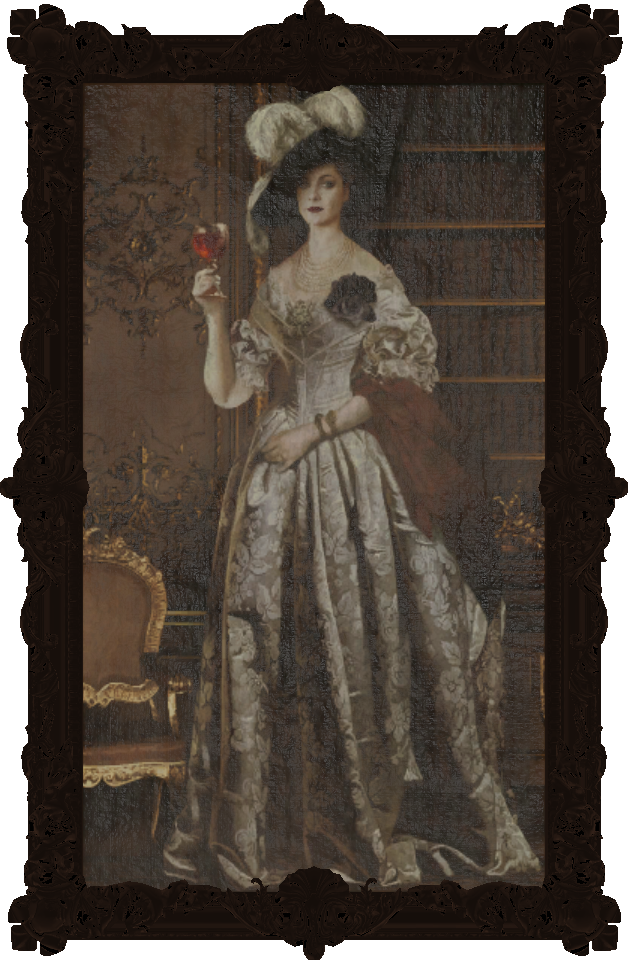

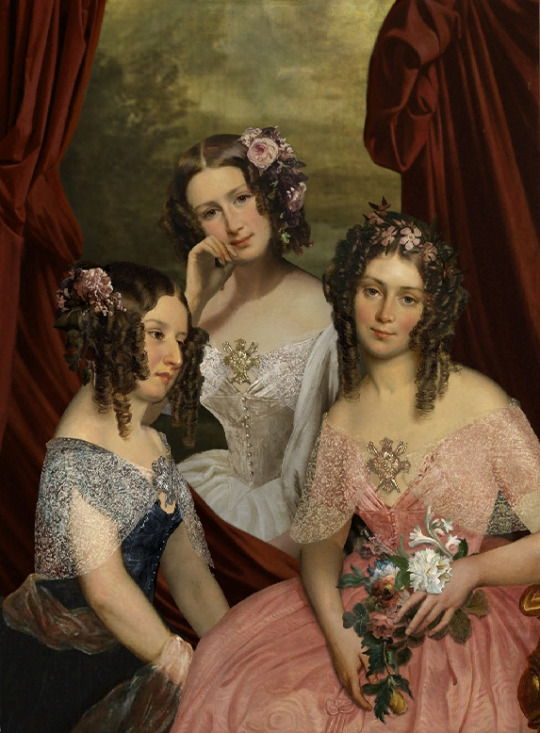

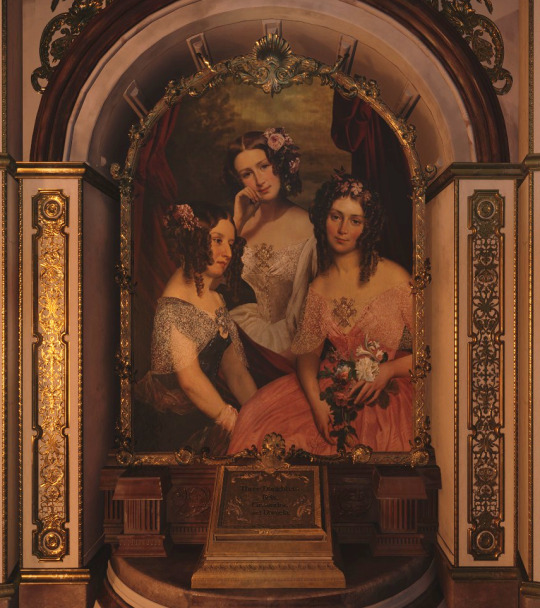
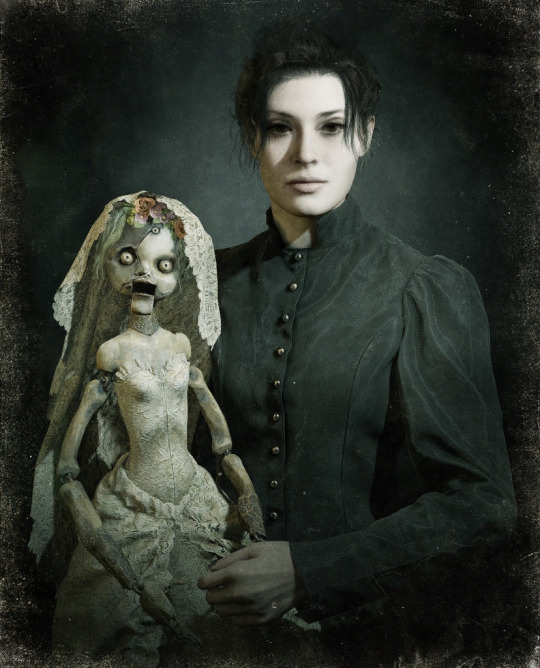
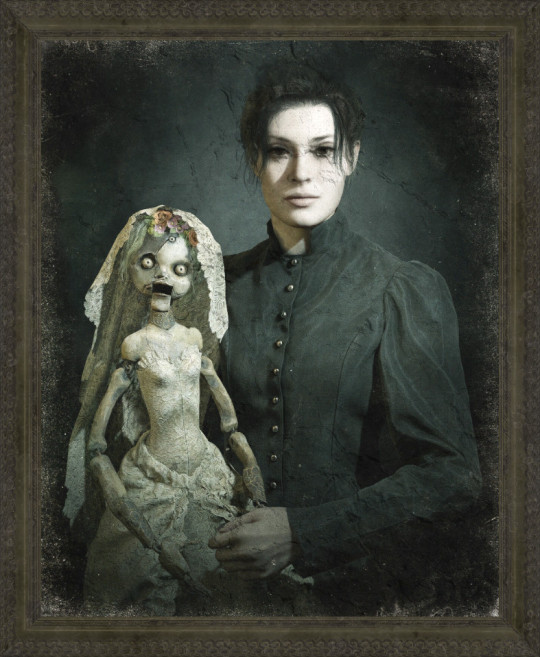
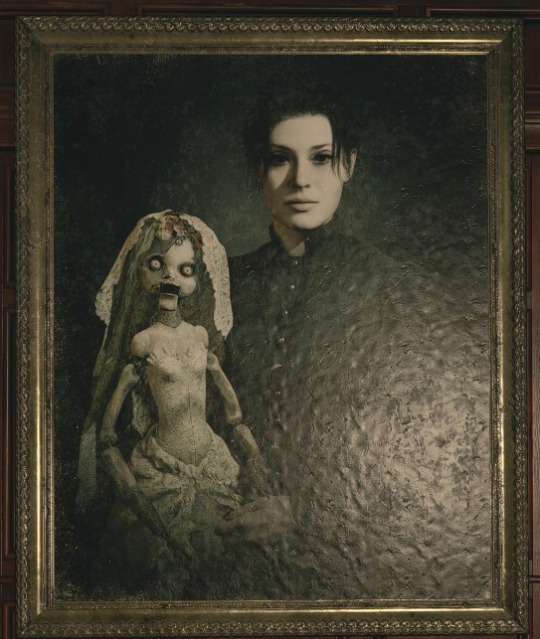


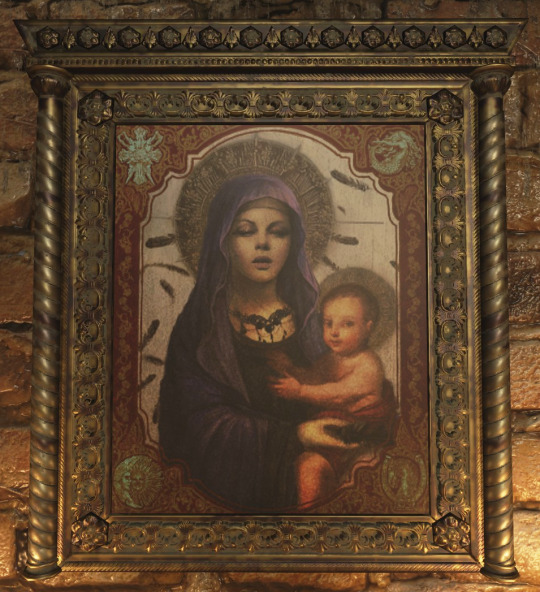
Portraits of Miranda's family: Image assets and renders
Have some assets and object renders of all those fancy portraits of Miranda, Donna and Lady D and her daughters! There are also many more portraits of Miranda herself to be found all over the village, of course, but I've posted those before. Not sure exactly why the Dimitrescu portrait is so much lower-res than the others (the actual picture is plenty big in-game), but this is the only version of it I could find in the game files.
The painting of the three daughters is (as you've probably heard before) based on a real painting by George Theodore Berthon called "The Three Robinson Sisters" ‒ and when I say "based on" what I mean of course is "it's the same picture, they've just tweaked the poses and added the Dimitrescu crest and a few extra details." But then, you can do that when a picture is over a hundred years out of copyright.
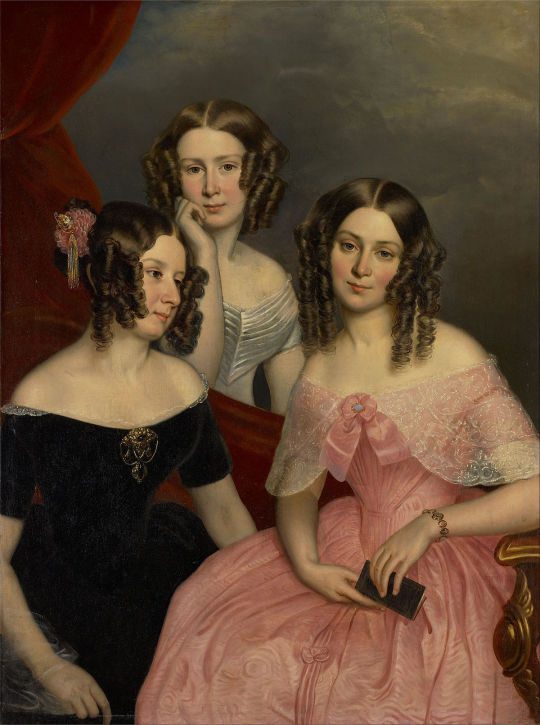
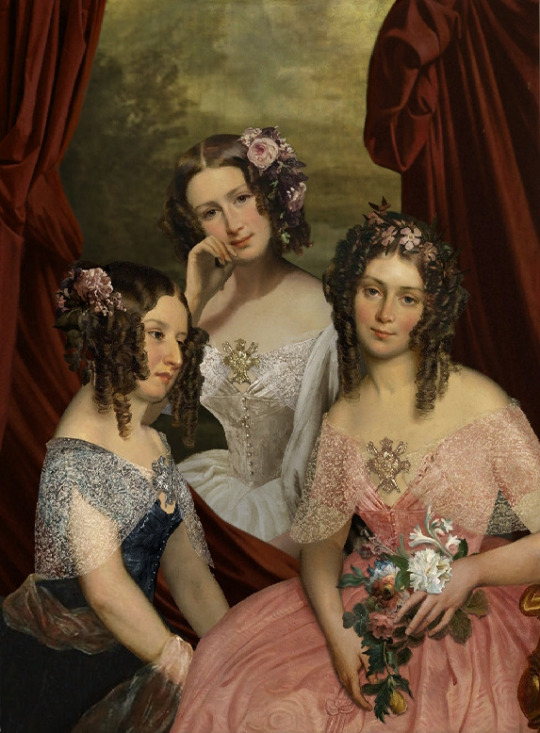
Whether the portraits of Dimitrescu and Donna were similarly based on specific historical art I do not know, though their faces look far more game-accurate, at least. Meanwhile, the portrait of Miranda so perfectly apes a thousand different madonna-with-baby images that I wouldn't be at all surprised if that slightly-creepy-baby comes direct from some original art piece, but who knows?
On a related note, has anyone else ever noticed the weird gender/class divide in Miranda's family? All five female family members appear in these flattering portraits (all seven if you count Angie and Eva), and Donna lives in a stately home and Dimitrescu in a castle, both attended by staff and servants. Heisenberg and Moreau, meanwhile, live in an old, run-down factory and a lake. The men do get their photos displayed in the church with everyone else's, of course, but that's hardly comparable to an actual painting.
There's arguably something of a technology divide too: though everything in the village seems old, Heisenberg's factory and the reservoir control mechanisms at least mark those areas as post-industrial revolution, and both feature major puzzles to get power generators running. But very little in Donna or Dimitrescu's domains would seem out of place in pre-Victorian times.
I don't think there's much meaning to be read into the gender divide (except inasmuch as you know Heisenberg plays up his filthy, lower-class persona just to get under Dimitrescu's skin) and I doubt it was even intentional. There's not much to suggest Miranda actively favours her 'daughters' over her 'sons', given Heisenberg's favoured treatment at Ethan's trial, and you definitely don't see the same kind of split in the Baker family of RE7, which gave us the gloriously revolting Marguerite. But as soon as you start digging into these characters, it's hard not to notice it all the same.
#Resident Evil Village#Alcina Dimitrescu#Donna Beneviento#Mother Miranda#Bela Dimitrescu#Cassandra Dimitrescu#Daniela Dimitrescu#Angie#Eva
340 notes
·
View notes
Text
For all the Sidlink fans upset about Sidon getting a fiance in TotK, I have an easy explanation/solution:
It’s a political marriage.
Sidon is royalty. He’s being crowned King. Royalty usually don’t get the privilege to marry for love, but rather need to do so in order to build political alliances and secure heirs. Mipha was able to consider proposing to Link officially because having the Champion of Hyrule as her consort would both strengthen their connections to what was the biggest political power in the area and be a great boon to Zora’s Domain in general, plus if they turned out to be biologically incompatible there was always Sidon for continuing the royal line.
Now, Sidon is the last in his line and trying to give his people a sense of stability while taking the throne amidst another huge upheaval. The kingdom of Hyrule is a shadow of what it once was, and Link himself was gone with no way of knowing if/when he’d return, as well as needing to spend his time/attention on all of Hyrule rather than the Zora specifically.
Meanwhile, Lady Yona is Zora royalty herself making her a good political match, she has qualities and skills that are well-suited to helping the people of Zora’s Domain, and she’s an old friend of Sidon’s which means they’ll probably get along pretty well. Marrying her as a political choice makes perfect sense. And Yona is a small enough character that we honestly aren’t given many indications that there’s more to their relationship than that- old friends who are marrying now to strengthen Sidon’s new reign.
That doesn’t mean Sidon is straight, or that he isn’t still in love with Link. And it doesn’t mean he can’t eventually pursue a relationship with Link, once things have settled down a bit. That sort of thing was pretty common with royalty historically (or at least for men- stupid patriarchy). In this case, Sidon and Yona could have arranged to have an open marriage, with both of them free to pursue matters of the heart outside of their political duties. Or at least, that’s how I’d write it if I was writing canon-compliant Sidlink.
So yeah, Sidlink as a ship is definitely not sunk, even if you do stay completely with canon. It just might look a little different. And I, for one, would love to see shippers play around with this new dynamic.
#totk#tears of the kingdom#sidlink#totk spoilers#tears of the kingdom spoilers#the funny thing is I'm more of a zelink shipper myself#but I hate to see m/m shippers stymied in such a way#or a female character thrown under the bus because of it#and I do genuinely think canon compliant sidlink is 100% possible here#have at it you crazy shippers /pos
906 notes
·
View notes
Text
As we celebrate public domain day and the start of Letters from Watson, I just want to say....
All queer Holmes headcanons are good.
All of them are meaningful to a multitude of people, and everyone finally has free reign to explore them in published works.
And I want to see all of them. They aren't in competition with each other.
I love explorations of what it would be like to be gay in Victorian society and all of the intricate historical connections people make. Both the painful ones and the ones that say fuck it, let's show some joy.
I love when characters are allowed to be bisexual and all of their relationships are treated with respect. I love when Watson gets to love Mary and Holmes, and when this isn't made out to be some competition.
I love aro and/or ace Holmes, and I beg certain corners of the fandom to remember that these explorations are not the same as simply not addressing the subject of Holmes' sexuality. They are so much more, and these interpretations are fundamentally queer. I love explorations of what it means for a queerplatonic partnership to be the most important relationship in someone's life, especially when they don't have the words to explain it.
I love explorations of Sherlock Holmes and gender. Whether it is someone concealing their gender to play a certain role in society or it is an exploration of being trans historically. All possibilities have something different and interesting to say.
Sherlock Holmes and the relationship between Holmes and Watson appeals to so many of us for a reason, and there are so many stories we can tell. There are so many ways authors can now say "I have always seen myself in this. Let me show you why." There is no limit.
I guess what I'm saying is this. Sherlock Holmes is now legally allowed to be kind and compassionate (and treat female characters well).
Here's to fandom doing the same.
#sherlock holmes#letters from watson#the ghosts of fandom wank past have been haunting me#please assume that I support interpretations not mentioned in this post and that I didn't intentionally leave anything out#this isn't based on anything I've seen yet#just some bad memories#I just want to see an old fandom resurrected#without it bringing back the worst of old fandom
1K notes
·
View notes
Note
The Current event makes me smile since it kind of confirms a headcanon I had that the Great Seven have animated movies based on them. Makes me wonder about the plot of the movies
Disney should get on the Twisted Wonderland AU Animated Remakes. What is Ursula was a good witch, what if Scar was right to take the throne and did he take it from Mufasa? (Or whoever is the stand in for him)
The Evil/Beautiful Queen...actually GOOD?
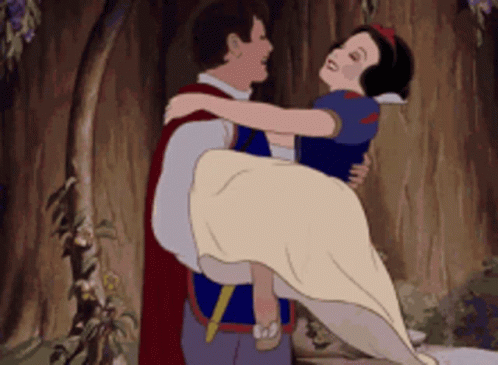
Yeah, it makes sense! Since the Great Seven are historical figures and the stuff of legends, surely there would be popular media made in their image. It’s like how the Disney fairy tales borrow from stories in the public domain or how there are historical retellings and reinventions (Hamilton, anyone?).
I believe TWST has mentioned films based on their own stories and history before too, but purely in the animated sense rather than live action. In book 3, Ace and one of the Atlantica Museum guards talk about an animated movie based on the tale of the mermaid princess and her prince; this movie is said to have come out ~30 years ago, which corresponds with Disney’s animated The Little Mermaid. Ace compliments the movie’s soundtrack too way to stroke your own ego, Disney/j.
Later on in Tapis Rouge, the characters discuss other films based on the Great Seven, including one Queen of Hearts movie. A Sea Witch movie is also mentioned; in it, she “goes gigantic” and also sings as she brews potions. The Octatrio quite enjoy this particular film.
(Side note: I don’t have the link for it anymore since it’s such an old post, but another anon once suggested to me that people probably also write fanfics of Neige and Vil since they’re celebrities… Think like “My mom sold me to One Direction?!” Wattpad kinds of fics, but replace One Direction with Vil or something.)
It’s… interesting this event specifically has Vil promoting a live action adaption of an in-universe animated film about the Beautiful Queen—an animated film which was the first full-color animated movie AND it originally released close to 90 years ago. They also reference the funding issues that Disney suffered while producing Snow White + inviting bank employees in to preview the movie to acquire more investments, stating that the studio that made the animated Beautiful Queen experienced the same. The in-game live action is even slated to come out “NEXT YEAR”. They’re not being subtle here with TWST’s references to their own version of the irl Disney Snow White (the live action is coming out in 2025, the OG is also almost 90 years old, etc.). I wonder if the EN server will actually get Tapis Rouge around the time of the irl release of Disney’s live action Snow White as part of a promotional campaign? 😂
UPDATE: There are even more not-so-subtle references to Disney animations in part 4 of the event, including discussion of cel animation, rotoscoping, adding blush to the characters, and how Disney brought in real animals/observed the “real thing” to help with animating similar scenes or subjects. They also cheekily say that most animation nowadays is CG 💀
I know some books under Disney publishing try to show alternate tellings or show the villains in a more sympathetic light, but I don’t know that they would ever commit to fully animating a film like that. It definitely would not happen in the style of traditional animation, Disney no longer seems well-equipped to handle that task 😔 I feel like it would also be pretty niche or might not get overwhelming positive reception with recent audience calls for “true bad guys” instead of twist or sympathetic villains (though I’m not sure what percentage of people watching Disney actually have this opinion).
I do wonder how those “AU” films would work though…? It wouldn’t be as simple as suddenly turning the G7 into “good guys”. The scenario and other characters would also have to drastically change. TWST doesn’t necessarily make the original “good guys” “bad” in a world where the villains are historical figures; we still hear plenty of positive or neutral stories about the achievements of the mermaid princess and other Disney heroes.
There are also times when the same story diverges into multiple separate stories that seemingly have no connection to one another. For example, there is a story where a princess marries a street rat (clearly referencing Aladdin) and they live happily ever after in spite of the difference in their social statuses. However, there simultaneously exists a story in which the Sorcerer of the Sands saves a princess from being deceived by a fake prince (also referencing Aladdin). The same goes for the mermaid princess (Ariel)—there is both a story referring to a “mermaid princess” who married a human prince and also a different story (clearly still pulled from the same film) about a mermaid who made a deal with the Sea Witch to find true love but broke her contract in the end.
Very cool idea, just not sure where it would lead or it it’s feasible or worth it monetarily for Disney.
#twisted wonderland#twst#disney twisted wonderland#disney twst#Vil Schoenheit#Evil Queen#Snow White#notes from the writing raven#fapis rouge in the shaftlands spoilers#Hamilton#Neige LeBlanche#twst en#twisted wonderland en#The Little Mermaid#Ariel#Ursula#Jafar#Aladdin#book 3 spoilers#Ace Trappola#Azul Ashengrotto#Tweels#Octavinelle#Jade Leech#Floyd Leech
133 notes
·
View notes
Note
I humbly submit samwise gamgee and/or frodo baggins. Time for the smallfolk to have a shot!
Frodo has been answered already, so let's tackle Sam.
So on the one hand Sam is an incredibly accomplished super spy. But on the other hand he is Down To Fight basically all the time. He's extremely dedicated but also the character most wracked by indecision - while occasionally being almost suicidally impulsive. He's terrified of wolves and of wizards... and he walks open eyed into things that terrify him all the time.
Sam is going to have a very easy time convincing Dracula he's totally harmless, snooping silently around the Castle, absorbing relevant information from his long historical rants, etc. But he's going to have a very hard time not constantly beefing with Dracula. He beefs with Aragorn while assuming he's a Black Rider! He gives Faramir a piece of his mind while he is his prisoner, knowing that this is Boromir's brother. He gets detained by cops and immediately starts insulting them. Every time he opens his big mouth he puts his foot in it.
On the other hand he is practical enough to know that there are some enemies too big even for him. He recognizes that Galadriel is out of his league. He knows he's no match for Sauron in his own domain, despite what the Ring is telling him. So the question is which category Sam sorts Dracula into: Guy Who Could Easily Kill Me or Unstoppable Force of... well not nature obviously because for both Tolkien and Stoker Nature is very good actually. Let's say Cosmic Horror.
Unfortunately I think Dracula reveals himself as an Asshole a lot faster than Dracula reveals himself as an Evil Wizard and Demon. (And like. Sam isn't that bothered by Evil Wizards either. He was gonna fight Saruman). There's no shaving incident because Hobbits don't shave. Sam is down to fight people holding him prisoner as a matter of course. Lizard climbing I don't think will freak him out that much - Gollum does that. It's not till May 16th that things Get Real. So do we think Sam can go ten whole days without telling Dracula what he really thinks? Given that he picks fights with both Aragorn and Faramir almost immediately upon meeting them I... don't think that he can. Or rather, I don't think that it would be immediately obvious to him that he needs to. Like, he definitely can keep his mouth shut. But that doesn't mean that he will.
Sadly, therefore, I think that Samwise Gamgee can not survive Castle Dracula.
120 notes
·
View notes
Text
Dionysus appears to people in a vast number of ways. His appearance changes depending on who He appears to and where.
This is something that is historically true: we see very different depictions of Him in writing, sculptures, mosaics, ceramics, and other mediums of Ancient art. In those pieces of art He takes a large number of forms: young and old, bearded and beardless, fat and slim, without visible muscle and with prominent musculature, tall and short, naked and dressed, with and without an ivy wreath, with soft features and with sharp features, long-haired and short-haired, and so on and so forth.
In writing, He is referred to as androgynous and spoken of as possessing multiple feminine qualities, be it of looks or character. Euripides has Him referred to as "girl-faced" (The Bacchae, lines 400-799) while inscriptions from Beroea dated 248-264 AD give Him the title Ψευδάνωρ ("effeminate man", lit. "false man"). Some researchers add that He is the only Deity whose domain doesn't correlate with His gender in the Greek language: the only word related to Dionysus that is masculine in grammar is ο κισσός, which means "ivy"; all of the other words related to Him are feminine.
I will attach some of His depictions to show just how Diverse Ancient perception of Him was. Dionysus is a God that is constantly changing His appearance, which is why whatever way He chooses to present Himself to you is valid.
Regardless of what gender presentation, body type, facial features, height, weight, or skin color you see Him as; none of these are wrong because He's choosing to appear to you a personal way.
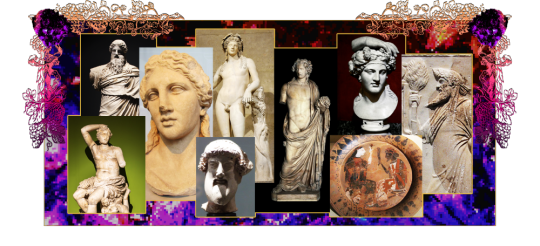
#𓆩☠︎𓆪 ˣ 𝐒𝖙𝖞𝖌𝖎𝖆𝖓#theoi#greek gods#roman gods#hellenism#helpol#hellenic polytheism#hellenic paganism#roman polytheism#dionysus deity#dionysus worship#dionysus
927 notes
·
View notes
Note
You know, regarding Lloyd's achievement in history and whether ordinary citizens know him or not made me crave post canon modern au.
Imagine seeing an in universe fanfic authors notes in ao3 or twitter crying about how they simply wanted to write a story set in Lloys time but they just keep diving into rabbit holes.
Kinda like
"So i was writing an historical au set in Alician era where the MC had a detour in Cremo and he was admiring a statue by the sea with a local explaining its history. Of course, I needed to do some research only to found out that Lloyd Frontera, YES, THAT Lloyd Frontera who made the Pantara railroad defeated some sea monster, nearly died and got statue for it"
Maybe someone from Beneto Kingdom being so confused because all he learned from history in school (Beneto history) is that Lloyd is just some brilliant engineer so he got specially confused on why in the movie he was watching set in Alician era is Lloyd fighting a goddamn bone dragon.
I'm interested on how scholars and political figures bemoan and analyse Lloyd's action and achievement but ordinary people's Internet discourse could be so much fun as well.
Javier and Lloyd getting the Alexander and Haphaestion treatment on whether they were lovers or not. The discourse would be so toxic lol.
oh my god forget changing the history of civil engineering forever, sparking the nastiest discourse ever on history/fandom internet forums is lloyd's true greatest achievement akshfksdg
he's the go to historical domain character used to set the time period for a historical movie/book/series. he's the guy writers insert to give their work a more period accurate vibe. everyone knows just enough about him to make really passionate history nerds very angry about all the inaccuracies and made up facts that are taken as common knowledge.
i'm thinking people of completely different online circles all knowing about lloyd in some capacity but regarding completely separate facets of his life and work and being so surprised when they accidentally find yet another whole field lloyd revolutionized. like.
a sword nerd who's really into the concept of the asrahan core technique and knows perfectly well that lloyd helped invent it getting gobsmacked about the fact that's the same guy that laid the ground for modern sewer systems.
a fan of historical romance stories who is used to seeing lloyd as a fun cameo in the background of stories set in the alician period being really confused when they open their book on thermodynamics and see there's a whole chapter dedicated to a method lloyd figured out to create ice without the need of magic.
a train enthusiast who is really fascinated by the rudimentary switchback system lloyd frontera implemented when the concept of a train wasn't even known in the empire being completely dumbfounded when their friends invite them to see a movie about that one time lloyd frontera and his knight defeated a knight of hell in namaran.
i think it's definitely a meme to post "so i was doing research for my asfahan au and went on a rabbit hole and guess who fucking built the qanat that's widely regarded as the only reason the kingdom didn't fall into civil war. take a wild fucking guess" "was it lloyd frontera" "IT WAS FUCKING LLOYD FRONTERA OF COURSE IT WAS"
i'm also certain there would be some guys who think he's overrated and people should really stop talking so much about him when there's so many other historical figures who are just as interesting and not as recognized 🙄. to which people immediately go "mad cause your history blorbo didn't defeat a bone dragon aren't you" at them
Javier and Lloyd getting the Alexander and Haphaestion treatment on whether they were lovers or not. The discourse would be so toxic lol.
they definitely get the alexander and hephaestion treatment you are so correct. they're also the achilles and patroclus of the modern magentano girlies. there's a bunch of 'queer retellings' of their lives. they're the go to example for homoerotic friendships. there's a bunch of edits that mix historical paintings of them with ship fanart with that 'history hates lovers' song playing over them. dudebros get really angry about it. llojavi truthers pull out their 20 pages long annotations that start with "they fucking slept in the same bedroom for years" and it only gets worse.
there's one poor person online who just really fucking wants to know how and why lloyd frontera changed faces one day out of the blue with no one ever explaining it. there's no official records. no member of the royal family ever made a statement about it. why is everyone acting like the frontera family didn't have one eldest son for 25-29 years and one day suddenly had a completely different one. what the fuck is going on.
so. yeah. i'm a little obsessed with this concept actually ajkshdksa
#hey i got an ask#myfracturedlife#tged#the greatest estate developer#lloyd frontera#llojavi#<- i guess??
118 notes
·
View notes
Text
the Trials of Apollo series by Rick Riordan:
30% “where are they now” on the PJO and HoO characters, starting 6 months after the end of the previous series. Results range from Percy “don’t involve me in this, I have to pass my midterms or Annabeth will kill me” Jackson to Jason “[spent about 5 months thinking he could have a life other than as blond-haired, blue-eyed, walking Heroic Archetype ‘Jason Grace, Son of Jupiter, Praetor of the Twelfth Legion’; that vacation is over]” Grace.
10% music references, and increasingly niche historical and mythological references
5% haiku so bad it’s only haiku on a technicality
10% oh fuck yeah FINALLY a child of Demeter is getting to be as OP as one of her “child of the Big Three” first cousins. Demeter was a child of Kronos and Rhea as much as her noisier brothers!
40% genuinely touching character development of Apollo begrudgingly figuring out how to be human and Meg grumpily figuring out to be who she wants to be, and both of them tentatively figuring out what real care for others feels like, both given and received; also, abusive parents can get fucked
5% interactions between gods and mortals, or gods and other gods, that make me physically vibrate with the desire to take this premise and plot away from Rick Riordan (portrays gods as Basically Just Some Guys, Nay, Chucklefucks, to be affectionately mocked), and give it to PC Hodgell or Lois McMaster Bujold or some other author who portrays gods with grandeur and awe (even when they’re sometimes being chucklefucks); with domains that define them and the terror, glory and responsibility of worshiping or being worshiped. Obviously Riordan’s approach is very good for Greek mythology (high chucklefuck to awe ratio), but gosh! I really like the other way, too! And these books brush against it in passing, without ever taking it seriously for more than about 1 paragraph!
62 notes
·
View notes
Note
my issue with infestation 88 is t hat it seems to be dogwhistling anti-semitism. jews have historically been likened to rats and this game is about gassing them. the title is also a dogwhistle, 88 for one but the word infestation has a scrabble score of 14. outlets shouldnt give this thing free press. i dont care that its a horror thing but this raises alarm bells
Thank you for this ask. I haven't gotten my laptop turned on yet but I was just about to make a post about this since most people seem to not have noticed the dogwhistles yet.
This post is made with speech-to-text, might be typos. It likes to turn antisemitism into separate words I'll edit it when my laptop turns on.
Yes, and the specific creators of that antisemitic garbage should be ostracized and boycotted and shamed so much they never try this shit again.
The problem is that so far none of the people complaining about the fact that horror things exist for Mickey Mouse now are doing so because they care about antisemitism, they're literally just doing it because they don't like that the public domain means even things they don't like get to exist.
There's a big difference between saying no horror things for Mickey mouse should ever exist because everything must cater to me and cater to Disney's image, and criticizing blatant antisemitism like with that game.
For those unaware, the number 88 is a Nazi dog whistle because if you convert the English alphabet into numbers, h becomes the letter eight, so 88 stands for HH AKA hail Hitler.
And if you think that's overly complicated and absurd that's the entire point and that's why it's called a dog whistle. Doug whistles are high-pitched whistles so loud that people can't hear them but dogs can. The point of dog whistles when it comes to bigotry is that the bigots know exactly what they are saying they are communicating perfectly, well everybody else around them just interacts obliviously and unknowingly helps spread the bigotry.
Do not support infestation 88 or the creators. That is just very blatantly anti-Semitism.
But the fact that these specific people are using Mickey mouse to be bigoted sacks of shit doesn't mean that Mickey Mouse should be copyrighted again and only Disney should be trusted to use this character.
Stop celebrating Infestation 88 when it's clearly antisemetic. You can't only care about boycotting anti-Semitic video games when they're made by people who also hate trans people. You have to give a shit at all times. You can't just say don't play JK Rowling's anti-semitic game because she hates trans people but then turn around to celebrate this.
71 notes
·
View notes
Text
frivolous or fated: buddha and beauty 🧖🏽♀️🛀🏽

Disclaimer: this is only part one (my document was too long to include in one post). If you would like for me to post part two, please let me know!
🛁 The predominant attitude towards the beauty of things in the classical texts is one of suspicion and met with usual hostility. Physical beauty, especially that of women historically, is accused of causing attachment and craving. Beauty is deemed as “the nutriment for sensual desire” in mercurial principles and thereby being acclaimed as the source of greed, hate, and delusion too. Enjoyment of one’s beauty, and repulsion at another’s ugliness, is deemed as incompatible with the great virtue of equanimity that enjoins us to be mindful and attain enlightenment without the filtering usage of the prism of worldly subjection. Whereas, worldly beauty is demonized, as it is attributed to distracting the masses from the ubiquity of suffering in this earthly plane. This is why in many buddhist principles, the antithesis to beauty-based seduction is focusing oneself upon bringing awareness to the “ugly”, such as death. Yet in countries like Thailand, beauty is theorized to be rewarded to women who have lived without expressing aggression, perpetuating hatred, and experiencing feelings of resentment in a previous life. Focusing on an object such as a disc (or a yantra in vedic culture), is taking in great beauty and bestowing the onlooker with tranquil meditation abundance. In this post, I will be evaluating what true beauty means in various cultures and how we can incorporate these theories into nuanced conversations about self care and overall beautification of oneself. The following deep dive into primarily eastern literature and spiritual concepts does not mean that these are solely accurate opinions, but it is designed to expand one’s palette to spiritual beautification outside of western ideologies.
🛀🏽 There are several modes of beauty. However, the main three categories of beauty I have stumbled upon are inner beauty, wordly beauty, and physical beauty. Inner beauty is the beauty of one’s character, the beauty of the person’s spirit, or moral beauty. But this inner realm or entity is not exactly disjoined from bodily and physical existence. It is simply the beauty that belongs to a person in virtue of their character, moral qualities, understanding, and experience. In contrast with the beauty of things or the world, there is substantial evidence for the importance of inner beauty in Buddhist knowledge. In the Cakkavatti-Shanda sutta, buddha answers his own question, ‘What is beauty for a monk?’, with a list of qualities such as “right conduct, restraint, perfection in habit, and an awareness of danger in the slightest fault”. In the verses of the female ancestors, who repeatedly celebrate their emancipation from the desire to cultivate physical beauty, there is an interesting reference to one nun, Subh, who it is said “went forth full of faith, beautiful by reason of the true doctrine”. In the Abhidhamma, whole sections are devoted to defining the various forms of beautiful consciousness and beautiful mental factors: including compassion, non-delusion and mindfulness (some of which are present in all the beautiful states of consciousness).
🧼 However these references towards beauty have sparked much debate. The word “beauty” is used to talk about “the inner”, about character and virtues. Translators have begged the question why does Buddha not speak of the restrained, alert, right thinking monk as simply being “good” or “holy”? Why is he described as beautiful? And why was Subh deemed beautiful, rather than just virtuous, by reason of dharma? This literature is explicitly stating there is a lack of connection between inner beauty with the beauty of things as seen, heard or otherwise perceived through the ordinary senses, such as sight and hearing. It is, after all, the domain of sensory/what may be perceptually experienced. As children, we learn the use of words like “beautiful” via connecting the term with what is visible, audible or otherwise available to the senses.

🧴 Prominent aesthetic-based philosophers Immanuel Kant (ashwini surya and revati chandra), Alexander Baumgarten (pushya surya and hasta chandra), and Francis Hutcheson (ashlesha surya and uttara bhadrapada chandra) studied the primacy of the sensorial experience by defining beauty in terms of sensory experience. But it has long been recognized that sensorial beauty was a sign of a more elevated form of beauty. For example, Plato, in Phaedrus, states that true beauty is something that one on the earthly plane may only discern when “reminded by the sight of beauty on earth” and that beauty is apprehended through sight: “the keenest of our physical senses”. The journey towards this appreciation of “true beauty” prescribed to Socrates by Diotima in The Symposium, is through witnessing the sight of beautiful figures (bodies). For Kant and others, it was believed that it is the beauty of God that finally matters. As Abbé Suger stated: “the multi-coloured loveliness of gems has… [transported] me from material to immate- rial things, for our dull mind is incapable of rising to the truth except through that which is material”. According to these ideologies, it is in this manner too that one should interpret Suger’s succinct definition of beauty as what pleases through being seen. This is a concept explicitly explored in the rashi of virgo. In my previous notions on virgo nakshatras, I have stated that the journey through this rashi is the journey towards uncovering the jewels of chitra through the eroticism of uttara phalguni and abstinence of hasta, the material cravings of the flesh have become transmuted into the immaterial learnings all virgo natives crave.
🪒 In Buddhist ideologies of beauty, some writers have proposed certain analogies between inner beauty and that of objects of perceptual experience with the intention of justifying their references to inner beauty. For example, a beautiful mind has been compared to a beautiful garden due to neither being considered wild or disorderly. Additionally, similar to carefully crafted art pieces, the beautiful mind possesses balance, proportion, and rhythm. However, unless such analogies are developed and deepened, suspicion about the merely figurative use of beauty will continue to arise. The mind of a man (note this is only in reference to men and not women in this literature) is controlled via craving/delusion and may be disorderly. However, is this “disorder” comparable to that of an untended garden?
🖼️ Some ancient texts argue the causal connections between moral character and physical beauty, with the potential purpose of inviting a transfer of the vocabulary of beauty from the latter to the former. For example, think of the passages mentioned earlier where Buddha describes physical beauty as a future karmic reward for a virtuous life. However, causal connections like this are insufficient to warrant a transfer of terms from physical beauty to its correlation to a person’s character. If references to inner beauty are to be justified, more intimate connections than ones of analogy and cause and effect need to be established between the inner essence of a person and the primary domain of beauty, things as experienced through the ordinary senses. So let us explore further…

🎀 Philosopher Ludwig Wittgenstein (ashwini surya, conjunct buddha to the exact degree, and uttara bhadrapada chandra) once spoke “the human body is the best picture of the human soul”. As a painting may express the feelings of an artist, so too the body, via gesture, comportment, facial expression, or demeanor, is an expression of a person’s inner reality, their character. Inferring only when the inner finds beautiful expression in the body, there is good reason to speak of inner beauty. Similar to when a person’s attitude is described as cheerful due to their cheerful smile and physical gestures that convey it to other people. In this case, the beautiful soul is “beautiful” because its bodily expression in the world is beautiful. Expression, therefore, is a kind of intimate connection required between the inner and the outer. The virtuous mind and/or character is only beautiful because it finds beautiful expression in and through the body. The idea that virtue, like courage, finds bodily expression is no more difficult and controversial than the idea of bodily expression of feelings, i.e. cheerfulness and sadness. A gesture, for example, is an expression of anger or courage when it is itself angry or courageous, and in a way that presents itself as having such a quality, at least to the mindful observer. So why should virtue find expression in beautiful gestures? Is this a matter of luck?
🧧 This connection is not at all a matter of luck. Beauty that is expressed bodily is the expression of virtue. We recognize and appreciate gestures, facial expressions and so on as beautiful precisely because we experience them as expressions of virtue. A woman’s smile, for example, is found to be beautiful because it is seen to express compassion. A monk’s comportment is deemed to be beautiful because it is experienced as an expression of humility. It may perhaps be that this expression of compassion or humility is faux. But that does not negate from the fact that our reasoning for finding the smile or comportment beautiful is the perception of it as an expression of virtue. Behavior that expresses anger may be feigned, that does not mean that the connection between angry behavior and an angry mood is merely contingent. Nor is the connection between beauty of expression and virtue. This is why bodily altercations for the purpose of increasing one’s beauty is not necessarily warranted for demonization.
🪭 This virtue-based attitude toward bodily beauty was personified by the words of Kant. Kant argues beauty belongs to the human body due to the body’s manifestation of moral virtues. There are similarities to this virtue emphasis in Buddhist texts too. For example, it is implied that it is appropriate to call Subh “beautiful by reason of dharma” because of the ways her holiness is manifested in her personal cleanliness and calm/grace of her comportment. Some testaments to Buddha’s physical beauty are centered around his sexual attractiveness to women who are “overpowered by passion” in his presence. Therefore, it is true that sometimes Buddha is found to be physically beautiful, even by people deemed to possess pure minds, as gentle dispositions are casual for other virtues such as fine countenance and posture to manifest. According to canonical texts, nearly all of which make for masculine physical beauty, include “the torso of a lion” and “straight limbs” of which are aspects of the Buddha’s comportment, such as effortless grace of movement, cleanliness, and calm that are expressions of his virtue. It is not only in Pali and Sanskrit literature that there is evidence of a virtue-based understanding of bodily beauty. In eastern asian Buddhist writings, there are similar understandings and underlying connections. For example, beauty is not merely of appearance, but of the spirit (suggesting both are intertwined). It is this inner quality that possesses beauty precisely because of the way it manifests itself outwards via grand gestures, glances and poise. Thus implying there is no warrant for referring to inner beauty as beautiful unless this beauty is expressed in and through the body.

📿 For a person’s character or inner reality to qualify as beautiful, it must possess magnetism. It must attract the heart. Whether this magnetism or attraction is thought of as a further condition of inner beauty, in addition to bodily expression, or as an aspect of this expression that deserves to be made salient in an account of inner beauty is up to one’s personal spiritual journey. Either way, it is through the body that a person exercises magnetism and attracts the hearts/adoration of others. This beauty must be magnetic and attractive via exerting radiance that draws people to it, is an idea found in the teachings of Plato, Plotinus and a minority of later Christian thinkers such as the pseudo-dionysius. It is this magnetism that distinguishes the beautiful from the good. Certain states of a person can be considered “beautiful” and this is due to the person who exemplifies such beauty embodying or mediating a certain concentration of energy. This energy sustains a certain demeanor and perspective and through this radiation and attraction. It is an energy that is aptly described as an object or form of eros (erotic love). For a person to count as beautiful, it is not enough that their virtue shows up in some way, such as solely via donations that one makes to charities or volunteer work. It must show up in an aesthetically charged way: via gestures, demeanor, style, and presence that draws others, sensitive to the energy being radiated, to the person. For just as there was recognition that inner beauty must be bodily expressed, so there is an acknowledgement in some Buddhist texts that inner beauty must attract.
🔮 Consider once more the texts that attest to Buddha’s personal beauty. Gotama was said to become radiant in the presence of Buddha’s beauty and seeing him there, standing in his beauty, men and women are drawn to devote themselves and offer reverence to him (similar to the powerful mahavidyas discussed in the vedic religion). Contrarily, consider the sequence of verses in the Dhammapada in which the search for perfection is compared to a bee’s search for a beautifully scented flower. In order to possess beauty, the words and actions of one must exude a perfume that attracts others. This perfume of virtue, one verse tells us, “gives joy to the soul”, as the light of wisdom is emitted by a truly enlightened follower of dharma. So too inner beauty exerts the same magnetism on the searcher for perfection as a flower’s scent attracts a bee. This theme of beauty’s magnetism is a persistent one. In the thirteenth century, Dogen observed that the body of a true follower of Buddhism feels at ease and “their actions take on grace”, so that this person’s “appearance attracts others”. In this text, Dogen is drawing upon not only Buddhist principles, but a Daoist and Confucian tradition in which the de (‘virtue’) of “the consummate person” or sage is conceived of in terms of charisma, of an inner goodness that is at power to influence and attract others.

🪔 Beauty’s magnetism is attested to by contemporary Buddhists as well. In “Attracting the Heart”, Samuels examines the aesthetics of the emotions in present day Sri Lankan religious life. Samuels’ research provides a source of Buddhist testimonies, mainly from monks and novices, in relation to the magnetic power of moral beauty. For example, he speaks of how they attempt to go beautifully in order to attract the people’s hearts via their dignified posture, speech, or cleanliness. Stating a monk must be “beautiful to the eye” or to the ear, when reciting verses in order make people feel longing for “the holy life”. As Samuels states, his research confirms that there is value in an aesthetic standard that informs Buddhist practice and invests into a quality of bodily movement, posture, speech, and action. Thus, inducing an aesthetically pleasing transformation. This attempted to justify the notion of inner beauty that several authors attribute to Buddhist thinking. Such a justification is at least intimated in Buddhist texts and testimony. Thus, virtue, in order to constitute beauty of character, must be beautifully expressed in and through the body, in a way moreover that exerts magnetism or attraction. Later on, I explore the possibility that a distinctively Buddhist understanding of beauty in art may be inspired by the Buddhist understanding of inner beauty. Earlier, I spoke of the assertion that awakened experience is an experience of beauty, but it may be right to suggest, immediately afterwards, that through the awareness sought by Buddhists, our appreciation of the arts is also enriched. If this is true, however, it will solely be attributed to the beauty appreciated in art as it is intimately related to the inner beauty previously discussed.

🧘🏽♀️ For some Buddhists, the most contrary feature to the religion of the ordinary discourse of beauty is its discrimination, on the basis of subjective experience, between beautiful and non-beautiful things. The “beauty” that simply stands opposed to ugliness is not true beauty… but deemed to be rather a dualistic idea according to Yanagi Soetsu (uttara bhadrapada surya and swati chandra). True beauty, Soetsu describes, is a state of mind, of “freedom from impediment and preoccupation”. For someone who achieves this state of mind, “everything is beautiful”, includ- ing all works of art. These remarks attempt to relate beauty in the world to an inner, ‘true’ beauty of the mind but not without nuance. Yanagi himself makes the very distinctions between beautiful and vulgar (or graceful and garish) artworks which can be contradictory. Whether or not an intelligible concept of beauty, according to which everything is beautiful, can be developed, it is clear that this would not be the ordinary, central concept of beauty. To be told that, in the Buddhist understanding of ‘true beauty’, all art is beautiful is, in effect, to be told that Buddhism has nothing to contribute to the aesthetics of beauty in art.
🎨 The challenge is to work outwards towards a notion of beauty in the world and in art, one that is compatible with discernment between the beautiful and the non-beautiful, from the notion of inner beauty previously spoken about. We have encountered, in effect, a clear-cut, paradigmatic, case of worldly beauty–in the gesture, demeanor, comportment or whatever bestows a beautiful expression to virtue of character, and thereby justifies reference to inner beauty. The body and its actions are in and of the world, their beauty is, in this sense at least, worldly beauty. Crucially, we have also encountered a case where beauty of bodily expression is at the same time a case of beauty in art. Zeami’s view that a certain kind of inner beauty manifests itself outwards in the gestures, glances and poise of an individual. But this individual is an actor, whose beautiful bodily expression therefore belongs to an art form. More generally, in an appropriate context bodily movements and activity may constitute artistic performance, such as a dance. In such contexts, there is no difficulty in seeing that art inherits, via the bodily activity that constitutes it, the inner beauty that it expresses.
🪻 This concept may be applicable to other arts and practices, including many of those that, in East Asia, are called “ways" (Japanese do, as in judo). Not all of these – swordsmanship, for example, or calligraphy (shodo), or the way of tea (chado) – are accepted by the standard Western connotations of ‘the arts’, and certainly not of ‘the fine arts’. But, in Asia, a distinction between arts and crafts, and between these and various other do, is not a definite one. Indeed, it is regarded as an artificial and potentially misleading dualism. Arts or ‘ways’ such as archery, the tea ceremony and gardening differ from dance and mime, typically, in having a practical purpose, such as hitting a target, making tea or creating a garden. That is one reason why these arts require the use of ‘instruments’--a sword, a tea whisk, a hoe–as well as bodily movement. But it is not unnatural to regard these instruments as extensions of the body, as specifically honorary parts of the body. For in none of these practices is the instrument deemed to be a mere tool, to be used in a way dictated solely by a goal. These instruments are to be used with respect and, like one’s hands, with expression. The gardener or tea master is not just clearing away weeds or brewing up a nice cup of tea. They are engaged in a practice that bodies forth the virtues, including compassion, humility, mindfulness, and friendship. In effect, they are concerned with practicing an art or following a way in a beautiful style. Like Zeami’s actor or a dancer in a Buddhist temple, the gardener and tea master via their own and their extended, ‘honorary’ body seek for beautiful physical expression of an inner beauty.
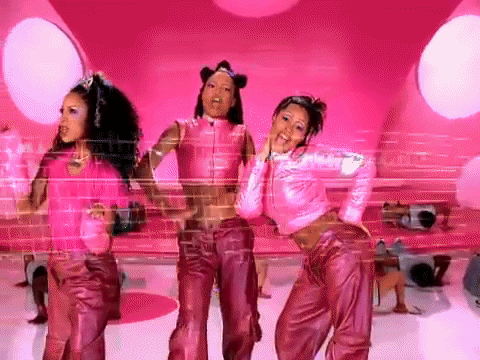
🎭 Many of the Buddhist-inspired arts or ways, the sharp distinction familiar in Western discourse between practice and product, between artistry and artwork, is rejected. It may be an exaggeration to say that, for gardeners, caring for the garden is not a chore, but the very point of having a garden in the first place. But it not only conveys that gardening is not a mere means to an end, the garden itself, but it is a place that depends on a gardener’s continuing care, the garden is not a finished product distinct from the practice of making and maintaining it. To focus, therefore, on the beauty of a practice is not, in the case of many ‘ways’, to ignore the beauty of something, the work, that is separable from the practice. Additionally, even when a distinction is made between a bodily action and its artistic product, many Buddhist artists would refuse to accept that aesthetic attention should exclusively, or even primarily, be devoted to the latter. It is easy enough, of course, to distinguish a calligrapher’s action in drawing with a brush and ink from the characters that are the result of this action. But when it is said of Kobara Sensei, that he and his art “had become one”, the point is to emphasize that the products of an individual’s art are not to be appreciated in isolation from admiration for the individual themself, for the virtues, like kindness, enable their works to look the way they do.
🩰 Kobara’s virtue, his inner beauty, enables his works to look as they do in and through the bodily movements, the physical style, that at once express it and create the characters on the paper. This is an example of the general way in which, for Buddhists, artworks inherit the inner beauty of the people who make them. By giving a sense of the beautiful bodily engagement through which they came into existence, the works themselves body forth the inner beauty of the virtues. Interestingly in twentieth-century Western art criticism, there also developed an appreciation of works as expressive of the bodily activity responsible for them. A significant aspect, for example, of people’s enjoyment of works by Van Gogh, Rodin and Pollock is the palpable sense these works require a certain strength and energy that went into their making. The difference between this occurrence in Western art appreciation and the more abiding Asian tradition is the concern in the latter for the moral beauty that is expressed in an artist’s bodily practice. By extending to art the idea of the body as being beautiful in and through its magnetic expression of inner beauty, it is possible, then, to endorse Batchelor’s beliefs that Buddhism is not just inner experiences. It is known through buildings, gardens, sculptures, paintings, calligraphy, poetry and craftwork’ and “present in” the marks and gestures of artists and artisans.

💋 Please do let me know if I should post the second installment of this document! I have been candid to some about my current health struggles and taking a leave of absence from ballet. I am so incredibly touched with everyone’s kind words and appreciate the amount of kindness i have been met with during these vulnerable moments. I love each and everyone of you and am deeply praying for your successes and triumphs. While I spoke of Buddhism in this post, I will talk about Buddha (mercury) and certain nakshatras correlated to this theory soon…
xoxo,
angel 💋
147 notes
·
View notes
Text
About some characters’ possible incarnations in previous samsaras
So Teyvat is trapped in a cycle, is constantly going through samsaras, and reincarnation really is all but confirmed now apparently.

A lot of people jumped to point at Childe and Parsifal, then speculate which other historical figures could also be his previous incarnations.

Childe's case is really, really interesting, but I wanted to bring up another character that also seems to be pulled into this samsara vortex somehow - Itto.
(This is gonna be long and have A LOT of reaches and speculations.)
Let’s look at Akuou (Touzannou) from Watatsumi Island. We don't have confirmation on which species he actually belonged to, but from what information we have on him, he would most likely be either a vishap hybrid, or an oni. He was described as “the wicked fangs and claws of the Great Serpent, the savage, demonic invader of Yashiori Island”. “‘Fangs and claws of the Serpent” makes it sound like he was a vishap, but I think him being called “demonic” is a more important characterisation here. The name ‘Akuou’ also may be a reference to the legends of Akuro'ou - “an ancient demonic warrior in the Japanese folklore who fought against the imperial court”, so again, demonic, an oni. And, well, oni also have claws and fangs, but I did have to mention that this guy could be a lizard person instead.
If we assume that Touzannou was an oni, we can start to notice a lot of coincidences pile up. First, Touzannou’s personality seems to resemble Itto’s - he was reckless, boastful, presumptuous, but very kind. Not the brightest mind, as it’s said that “his strength was his only strength". He came up with his own fighting styles that are still passed down on Watatsumi. Itto’s fighting style is his own as well:

(I love Itto so much man.)
Touzannou fought the Tengu Sasayuri and was called Akuou - “Wicked King”; Kokomi’s Everlasting Moonglows story mentions it like that:

Itto’s Redhorn tells a story about an “Otogi King”, who was boisterous and boastful too. And that’s where it gets weird, please walk with me. One of Itto’s passive talents is getting more wood, and if we look at how the trees are distributed on the map, the VAST majority of the Otogi trees are found on Yashiori Island.

As already mentioned, Yashiori was invaded by Orobashi and his people 2000 years ago, and ultimately became the resting place for Akuou (Touzannou) and shrine maiden Mouun, a very important figure I’ll talk about later. 99% of Itto’s story quest also happens to take place on Yashiori.
A cornplate detail, but Itto was also at Nazuchi Beach (Yashiori Island sub-area) in his dedicated album posted on genshin’s youtube channel. The ost playing on Nazuchi Beach is called Stranded Wish, which is quite an interesting name choice for a place that suffered so much tragedy and war.
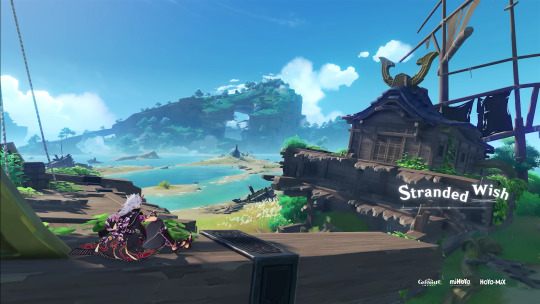
(This is also actually a Watatsumi ship, as mentioned by an npc we can talk to there)

Speaking of Watatsumi, Itto’s most obvious connection to it is through Gorou, as he is his dedicated support. The less obvious connection is his similarities with Akuou, and some things involving Kokomi. Sure, his quest is only accessible after you complete Kokomi’s, and their signature artifacts in the same domain, but her involvement seems to run a bit deeper than that.
You see, the whole thing that started it all is Akuou being mentioned in Kokomi’s donut. At first I thought it’s actually the same guy from the Redhorn, because their description was so similar, basically just ‘evil king that fights a tengu’. But it was exactly this description that made me notice some interesting pattern of interconnected characters.
2000 years ago: Akuou the Evil King, Mouun the shrine maiden and Tengu Sasayuri.
500 year ago: Tengu Reizenbou, Asase Hibiki and Ako Domeki.
Present day: Arataki Itto, Kokomi, and Kujou Sara.
Take a look at depictions of Asase Hibiki (left) and Mouun (right) from the TCG cards:

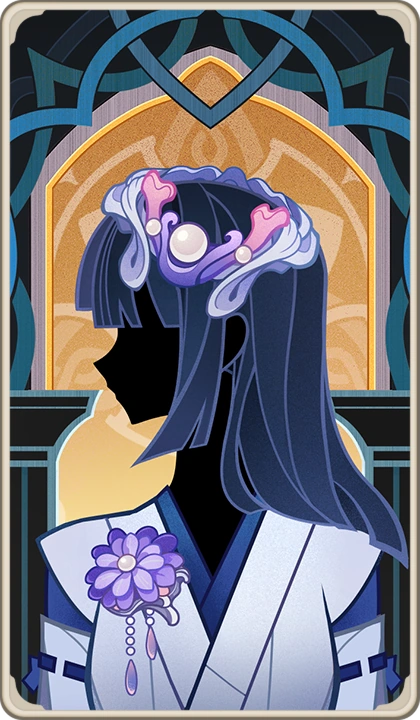
Their haircuts seem to be identical, with the hair color being the only difference. Better yet, it's also similar to Kokomi's haircut.
The oni from their respective time periods (or samsaras) are named Akuou, Ako and Arataki. Inconsequential, but interesting.
Let’s take a look at Ako Domeki, and speculate a little (or a lot). Both Akuou and Itto had conflicts with a tengu, but Ako seemingly didn’t. But, since he’s 500 years back on the timeline, it puts him on the same time period as Tengu Reizenbou and the ‘otogi king’ from Itto’s redhorn. There is a slight chance that this ‘otogi king’ was actually Ako Domeki post Serai and Golden Apple, but there’s nothing really to prove or disprove this, apart from the fact that they both have similarities with Akuou and Itto.
Another thing that could possibly have something to do with Ako Domeki are those weird oni symbols scattered around Watatsumi. These symbols are connected to Rinzou's Treasure world quest - you look for pirate treasure, and find Rinzou’s letter where he talks about his life.

This “outlander king” inspired Rinzou to leave Watatsumi when he grew up. And, it’s interesting that he chose an oni mask as his insignia when he left Watatsumi. If this old man was the reason for him to go into the world to seek adventure at sea and become a pirate, it would make sense for his insignia to be inspired by this old man. Which would make him an oni.
Could this be Ako Domeki, an oni pirate, that inspired another person to become a pirate? It’s far-fetched, but again, as we don’t have any confirmation for the end of Ako Domeki story, it could have really been him.
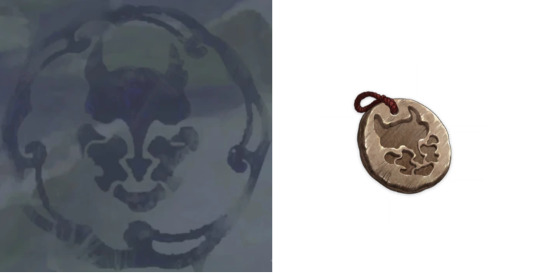
Getting back to Akuou and Mouun. Mouun’s name has a very interesting possible origin:

Kokomi’s ‘slumbering dragon’ constellation comes to mind here.
Mouun was friends with a great 900 year old whale called Daikengyou.

They both were slain during the Yashiori Island invasion. But, the fact that this whale managed to live for so long almost definitely means that it was no ordinary whale - perhaps it was the same creature as the All Devouring Narwhal.
Meanwhile Kokomi had a whale in her demo, which should definetly raise some red flags.

Akuou was taught different rituals by Mouun and her sister Ayame, including an art of whalesong. Interestingly enough, Itto is a very good singer apparently:

So, in light of recent developments with whales in the main story, I don’t really think that this art of ‘whalesong’ was something connected to ordinary marine life, it’s too specific now. Given that Orobashi was actively opposing Heavenly Principles, I won’t put it past him and his followers to be involved with the likes of Surtalogi that keeps celestial whales as pets.
Last thing, the books about Akuou and Mouun, as well as about other Watatsumi dealings (Debates on the "Viceroy of the East", A Preliminary Study of Sangonomiya Folk Belief, The Life of Mouun the Shrine Maiden, and more) are not in the book archive, but in the quest items. Must be important.
So, let’s round things up. Akuou, Ako Domeki, Arataki Itto, all with similar sounding names, are boisterous, kind oni, that all have mentions of being called ‘kings’ (Itto’s ult is called ‘raging oni king state’), all have some ties to Yashiori Island (Ako Domeki is mentioned on a note on Nazuchi Beach, and if the Otogi King and him really were the same person, there’s Yashiori having the most otogi trees in Inazuma), all being exceptional fighters, all having ties to a notable tengu and a shrine maiden, that also have connections to characters taking on the same role from a different time periods.
Ako Domeki is up in the air, but Akuou and Itto really do seem to be connected somehow.
#THE VOICES#it's 3 am and everything feels like a conspiracy#genshin impact#genshin lore#genshin theory#sangonomiya kokomi#arataki itto#kujou sara#gorou#i'll proofread this in the morning if i don't forget
63 notes
·
View notes
Text
Public Domain cartoon characters from Golden Age comic books



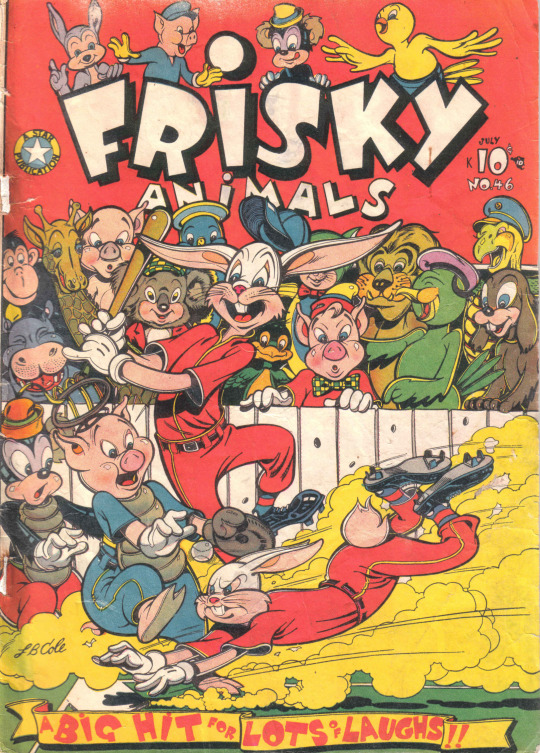
Mickey Mouse, Winnie the Pooh, and Oswald the Lucky Rabbit going (mostly) into the public domain is a pretty big deal. In the next ten years a lot of animation from the 1930s will wind up in the hands of all artists who want to use them.
But did you know there's a huge amount of cartoon characters from the 1940s that are totally free to use? It isn't just cartoons that starred on the silver screen that have fallen out of copyright.
(Of course, I'm using the word "cartoon" somewhat loosely...)
See, when US copyright law was revised in 1976 and went into effect in 1978, works created before 1964 were required to have their copyright renewed before the end of 1980, or else they would become public domain.
Hundreds if not thousands of Hollywood movies and other types of media had been made by studios and publishing companies that went bankrupt and were completely dissolved decades prior to this new law. This included the cartoons made by studios such as Bray, Van Beuren, and many others- but it also included comic books.
If you weren't a big comic book company like DC or Marvel, chances are you shuttered your doors sometime in the 1950s or early 1960s. And during the 1940s, with the rise in popularity of Looney Tunes, Woody Woodpecker, Tom and Jerry, and Droopy, comic book publishers were printing tons and tons of comic books starring wacky, slapstick-oriented animal characters.
Most of these titles went out of copyright, and there are lots of fun and interesting characters to be found in them.
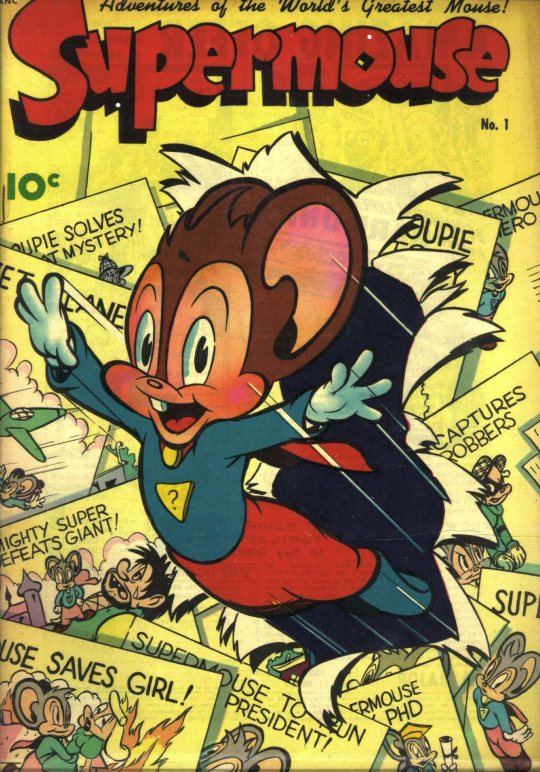
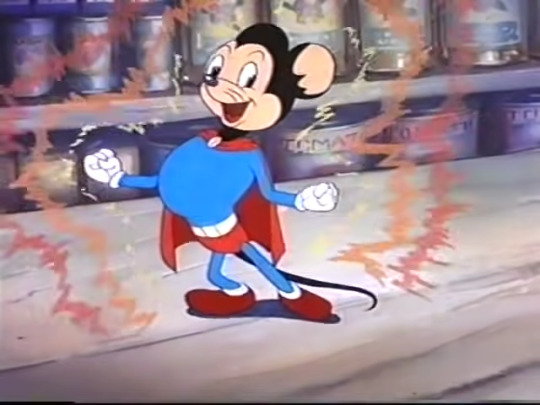
One of the most historically notable is Supermouse. When the first Mighty Mouse cartoon premiered, he was called Supermouse, but what they didn't know was that Pines comics had already taken the name, and successfully sued for copyright infringement even though they were both parodies of Superman.
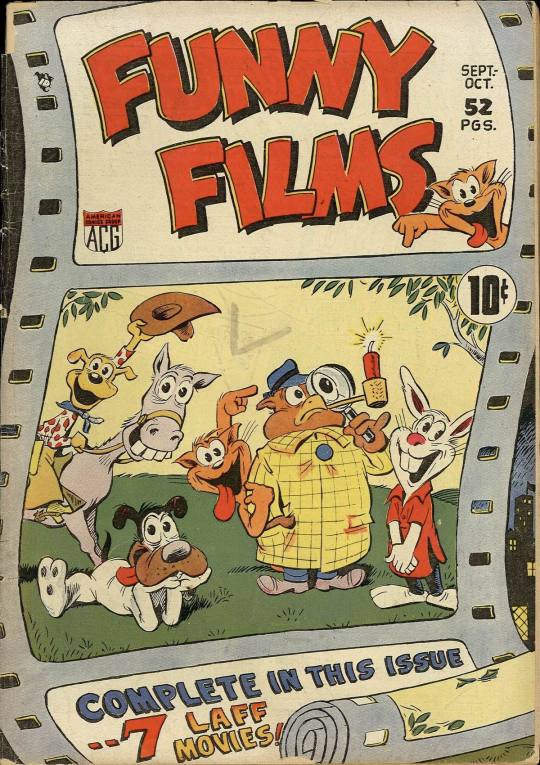

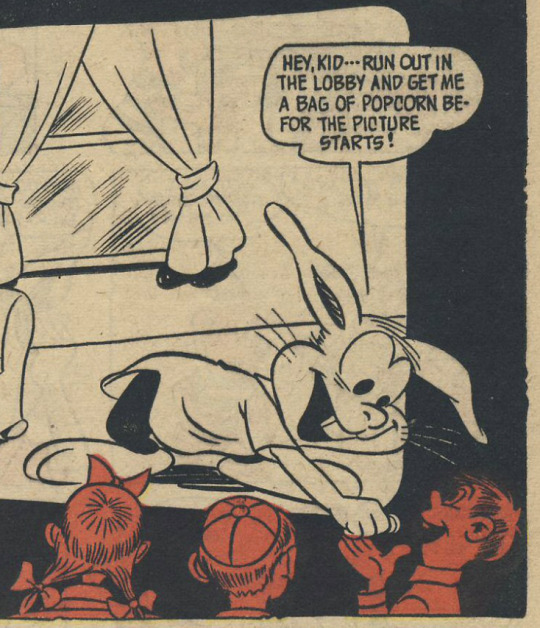
One of the most interesting titles I've come across is Funny Films. The conceit of the series is that these are actually cartoons you can watch in a movie theater, except it's a comic book. A bit confusing, I know.
The end result is a series of fourth wall breaks so absolutely thorough in their scope that the fourth wall really doesn't exist anymore, barring actually jumping out of the page (or your computer screen) and blowing up your living room. They talk to the audience, jump out of the screen, and even show up late for the cartoon to start.
This is of course the bookends to a whole bunch of slapstick gags and goofy dialogue.
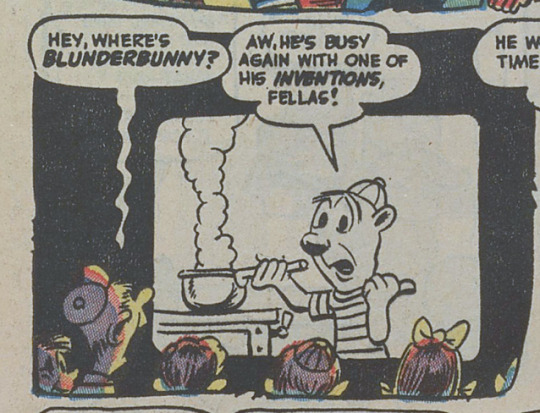
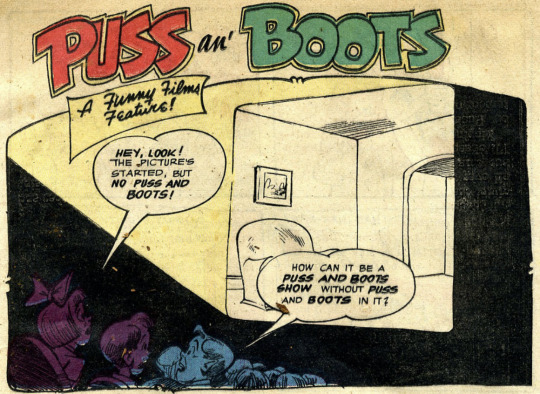

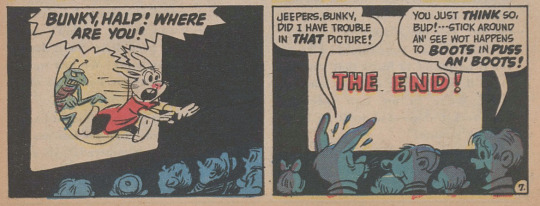

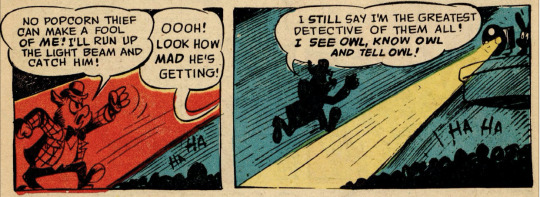
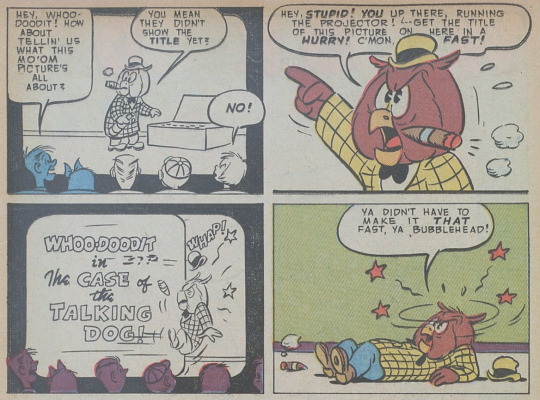

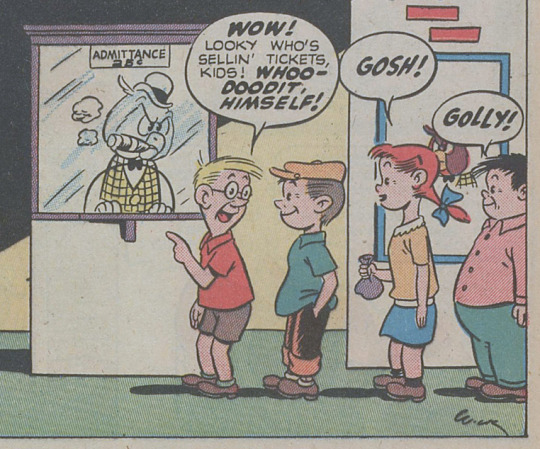
Another interesting series, especially if you're a fan of Archie, is Hi-Jinx. They basically took the premise of teeny-boppers in high school and made them into funny animals. Most of the stories have something to do with swing music and dancing.
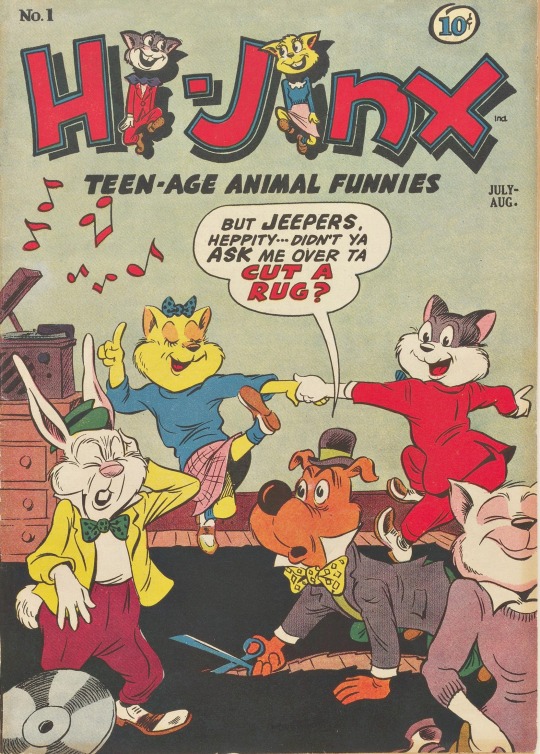
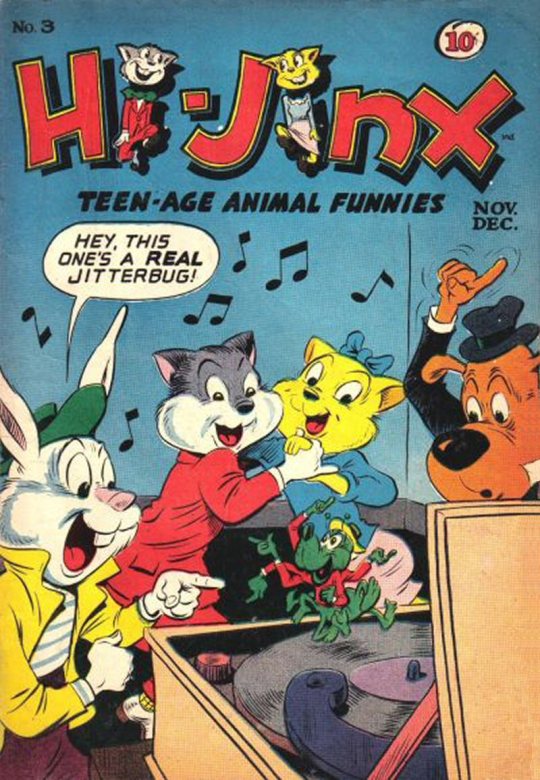
And although they're crudely drawn, one of the more unique character concepts is Pussy Katnip, found in various titles scattered across the mid-1940s, usually buried amongst a bunch of more normal stories with ordinary human characters. Pussy Katnip looks like one of your classic film noir glamorous beauties, except she's an anthropomorphic cat. Think Minerva Mink but feline.
She may appear to be a femme fatale at first, but she's actually a crimefighter. To do this she chugs a mysterious beverage that gives her enhanced strength and intelligence. She's sort of a mystery-solving superhero.

Her appearances are random and kind of hard to find. Here are the titles of the ones currently circulating online:
All Your Comics (1944 issue)
All Top Comics (one-shot)
All Good Comics
Everybody’s Comics (1944 issue)
Green Mask v1 #11
Ribtickler v1 #1
All Great Comics (1945 issue)
Book of All-Comics
Green Mask v2 #2
Rocket Kelly #2
Zoot Comics #1
Often these comics, especially in the early '40s, remind me of the artwork of underground comics of the '70s- not quite rubberhose, not quite Looney Tunes. The kind of thing you might find on a punkabilly album cover.
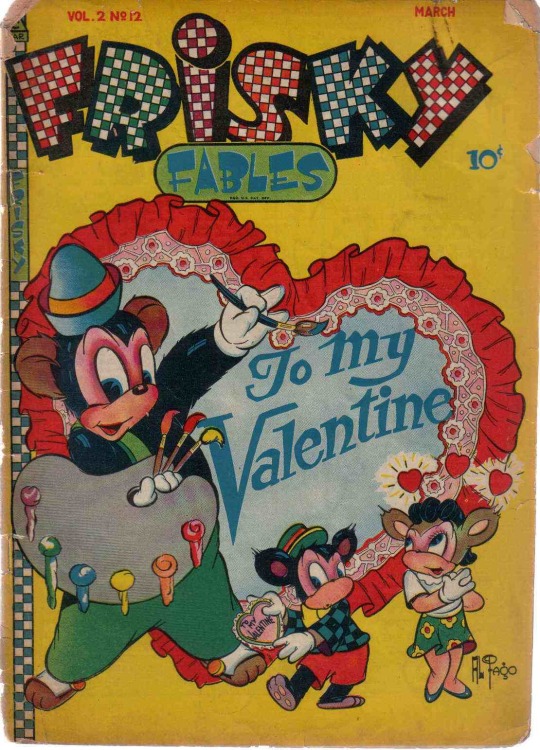
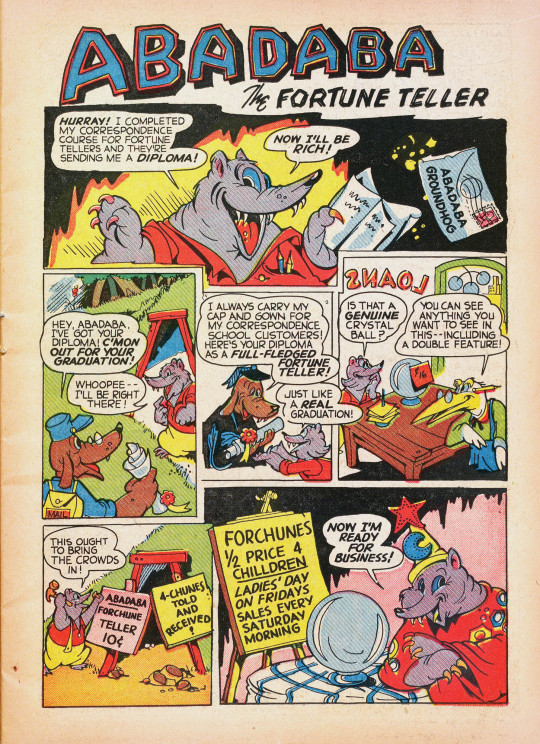

And ocassionally you'll come across characters with a suspiciously familiar name:

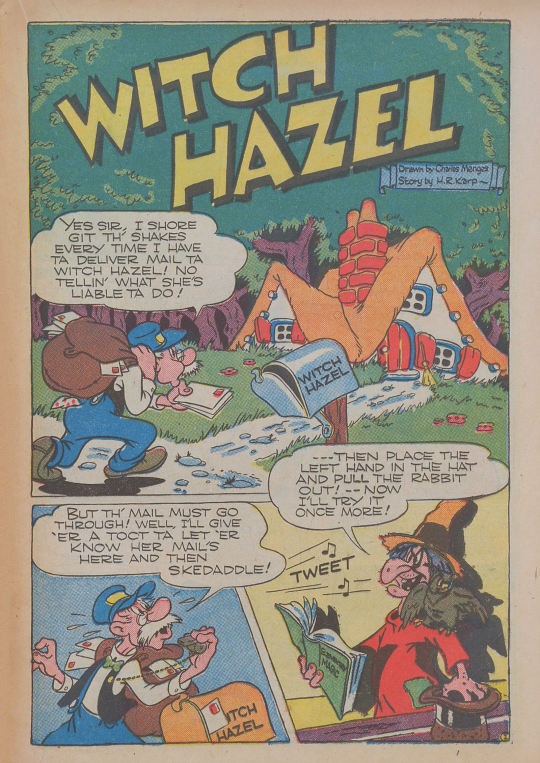
One thing to watch out for is the occasional Donald Duck knock-off, some more obvious than others.
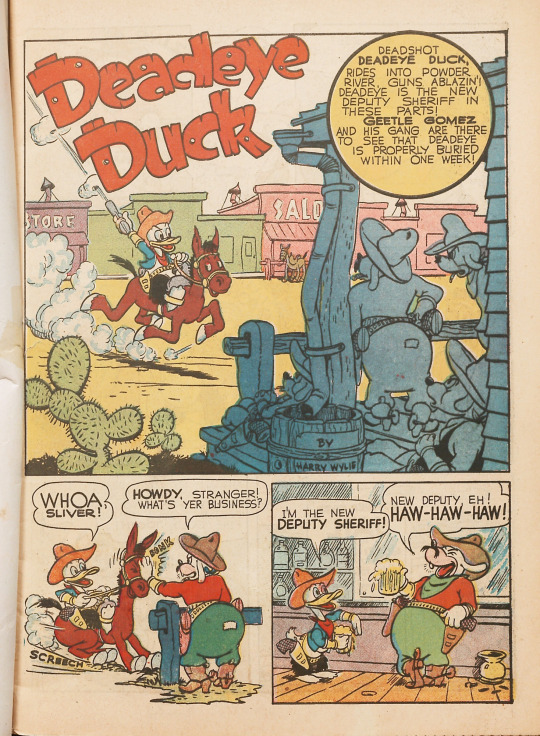
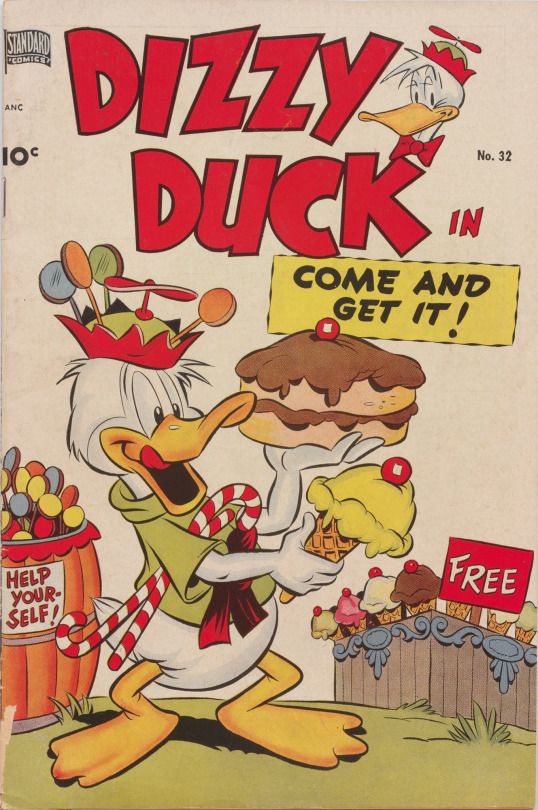
Now you may be asking: Where can I read these comics?
Simple: https://digitalcomicmuseum.com/
Just be sure you have the right software to read them. I use cooViewer.
Another incredibly useful resource is www.comics.org.
So if you're like me and you're too impatient to wait for Bugs Bunny and Daffy Duck to fall out of copyright, and you want to do something more unusual and unexpected, there are dozens and dozens of comic books with silly, wacky characters that can be utilized in your own original stories, cartoons, and what have you- and you can monetize them too!
#mickey mouse#steamboat willie#winnie the pooh#oswald the lucky rabbit#disney#foxy fagan#supermouse#super mouse#mighty mouse#puss and boots#blunderbunny#whoo-doodit#pussy katnip#cosmo cat#buster bunny#witch hazel#donald duck#deadeye duck#looney tunes#cartoons#toon#animation#comic books#comics#golden age#fox#wolf#bear#rooster#chicken
36 notes
·
View notes